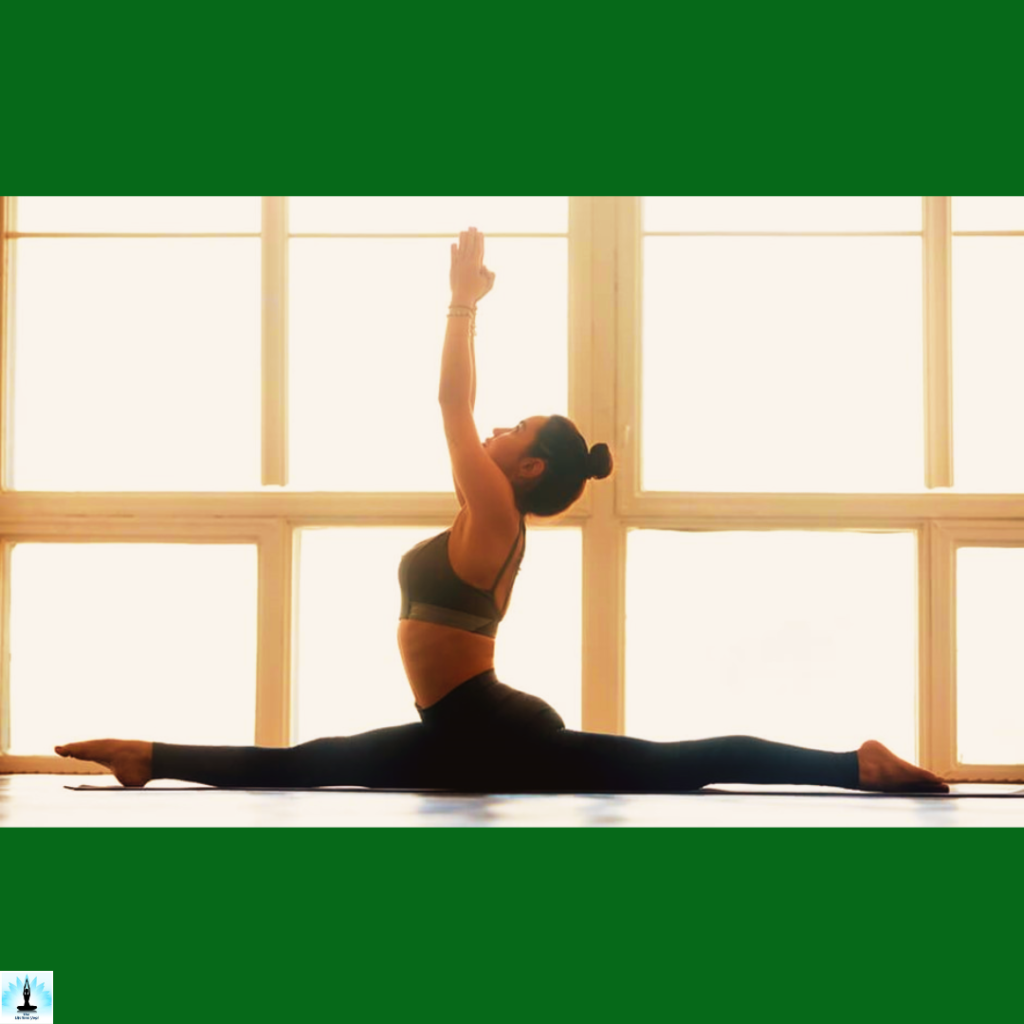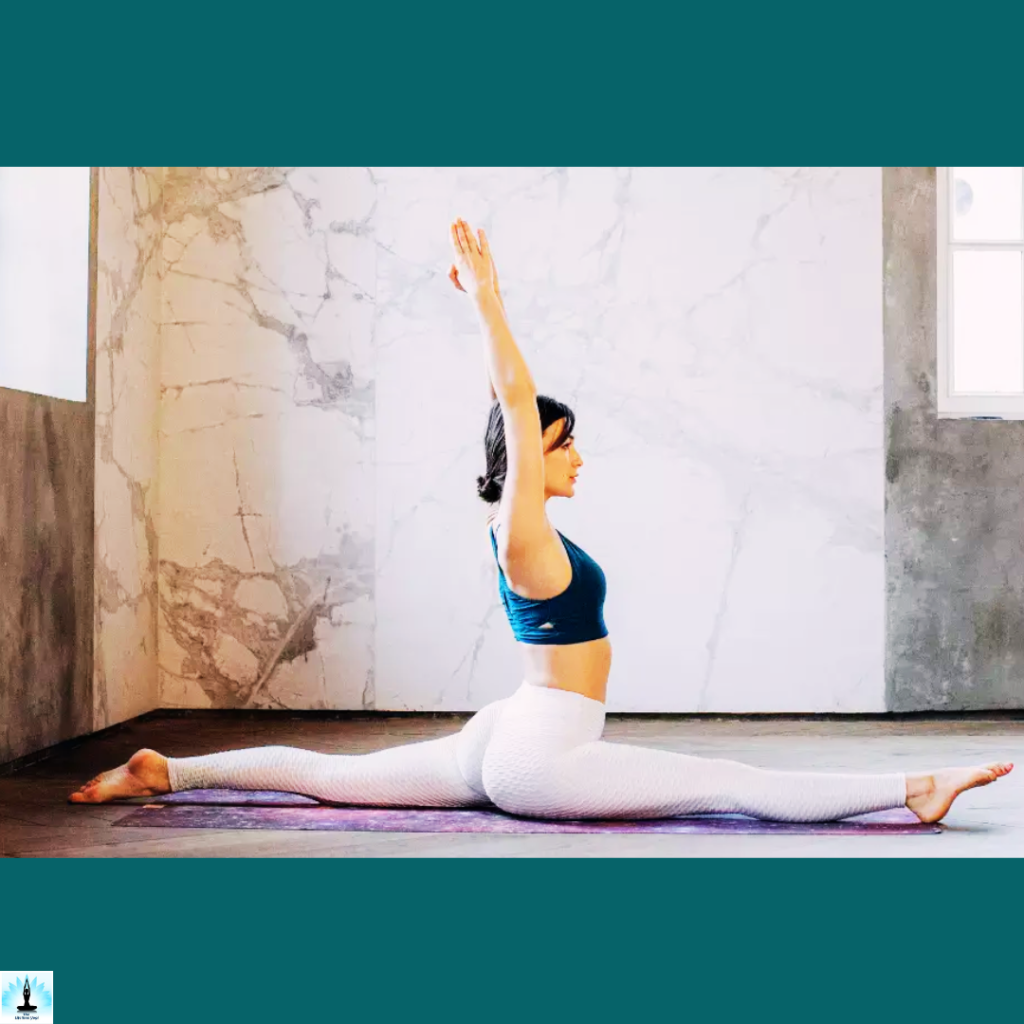Introduction – Top 8 Benefits of Hanumanasana and 6 Step by Step to Perform Hanumanasana
Welcome to the world of Hanumanasana, also known as the Monkey Pose. This powerful yoga posture is named after Hanuman, the Hindu Monkey God, known for his strength, devotion, and agility. Practicing Hanumanasana can bring a multitude of benefits to your body and mind, from increased flexibility and strength to emotional stability and spiritual growth.
Key Takeaways:

- Hanumanasana is a powerful yoga pose that can enhance flexibility and strength.
- It has a deep symbolic significance in yogic philosophy, reflecting qualities such as devotion, humility, and strength.
- Preparatory poses and therapeutic applications can help you deepen your practice and address physical or emotional issues.
The yogic philosophy of the Hanumanasana
In yogic philosophy, the practice of yoga is more than just physical exercise; it is a way of life that seeks to unify the mind, body, and spirit. Each yoga pose is imbued with deeper meaning and symbolism, and Hanumanasana is no exception.
Named after Hanuman, the Monkey God of Hindu mythology, this pose reflects Hanuman’s legendary strength, devotion, and humility. According to Hindu mythology, Hanuman was a faithful servant of Lord Rama who possessed incredible strength and agility, which he used to help Rama defeat his enemies. Hanumanasana is said to reflect Hanuman’s unwavering devotion to Lord Rama, as well as his ability to overcome obstacles with grace and humility.
The pose also reflects the qualities of the monkey, which is seen as an agile and playful creature in both Hindu and Buddhist philosophy. Monkeys are known for their ability to navigate complex and challenging environments with ease, much like the challenges we face in our own lives. Hanumanasana is therefore seen as a symbol of adaptability, flexibility, and resilience in the face of life’s obstacles.
The Chakra Significance of Hanumanasana in Traditional Yoga Practice
Although Hanumanasana is a challenging pose, it is considered an important part of traditional yoga practice. In fact, it is often included in the advanced poses practiced by yogis in India. The pose is believed to stimulate the navel chakra, or Manipura, which is associated with the element of fire and the qualities of courage, discipline, and willpower.
Benefits of Hanumanasana
Hanumanasana can positively impact various aspects of your well-being. Some of the key benefits include:

1. Hip Flexibility: Hanumanasana is one of the most effective hip-opening poses in yoga. It deeply stretches the hip flexors, groin, and psoas muscles, promoting increased flexibility in the hips and thighs.
2. Quadriceps Stretch: The back leg is extended in this pose, which provides a stretch to the quadriceps, helping to release tension and improve overall leg flexibility.
3. Emotional Release: Deep hip opening poses like Hanumanasana are believed to hold emotional tension. As the hips release, practitioners may experience emotional release and a sense of letting go.
4. Improves Circulation: The pose encourages blood flow to the pelvic region, which can be beneficial for reproductive and digestive organs.
5. Stimulation of Abdominal Organs: Hanumanasana activates the abdominal area, which can help improve digestion and stimulate the organs in the abdomen.
6. Therapeutic for Sciatica: When performed with proper alignment, Hanumanasana can alleviate sciatic pain by stretching and releasing the muscles surrounding the sciatic nerve.
7. Energizing Effect: While it can be a challenging pose, Hanumanasana can invigorate the body and mind, leaving you feeling refreshed and energized.
8. Spiritual Connection: Hanumanasana is associated with the Hindu deity Lord Hanuman, symbolizing devotion, courage, and the willingness to take a leap of faith, providing practitioners with a sense of spiritual connection.
Monkey Pose: Step-by-Step Instructions

To perform Hanumanasana, also known as the Monkey Pose, follow these step-by-step instructions:
- Begin in a low lunge position with your right foot forward. Place your hands on the floor on either side of your right foot.
- Slowly begin to straighten your right leg while keeping your hands on the floor for support.
- As you straighten your right leg, begin to slide your left leg back behind you, keeping the knee and top of the foot on the floor.
- Gradually shift your weight forward onto your right leg as you slide your left leg straight behind you.
- Keep your hands on the floor or bring them to your hips, lifting your torso to an upright position.
- Hold for several breaths, then slowly release and repeat on the opposite side.
Remember to breathe deeply and stay connected to your body throughout the pose.
Step-by-Step Guide to Perform Hanumanasana with Props
If you are new to Hanumanasana or have tight hips, you may benefit from using props to support your practice. Here is how:
| Prop | How to Use It |
| Yoga Blocks | Place one or two blocks under your hands to help bring the floor closer to you. You can also place a block under your back thigh for support. |
| Bolster | Place a bolster or cushion under your back thigh for added support and elevation. |
| Blanket | Place a folded blanket under your back knee for extra cushioning. |
Experiment with different props to find what works best for your body.
Advanced Variations of Hanumanasana
Once you feel ready to attempt Hanumanasana, there are a few variations you can try to deepen the pose and challenge your practice.
| Advanced Variation | Description |
| Quad stretch variation | Interlace your fingers behind your back, stretching the front thigh while deepening the stretch in the hip flexor. |
| Standing variation | Instead of starting from a low lunge, begin in a standing position and extend one leg forward into the full pose. |
Remember, it’s important to listen to your body and only attempt variations that feel safe and comfortable for you. Don’t push beyond your limits or try to force yourself into the full pose before you’re ready.
Therapeutic Applications of Hanumanasana
Hanumanasana can have significant therapeutic benefits for both the body and mind. Here are a few ways that this pose can help improve overall well-being:
- Hip and Hamstring Flexibility: Hanumanasana is known for its deep stretch in the hip flexors and hamstrings, making it an excellent pose for relieving tension and tightness in these areas. This can be particularly beneficial for those who spend long periods of time sitting throughout the day.
- Digestive Health: By opening the hips and stretching the groin, Hanumanasana can help stimulate the digestive system and promote healthy digestion. This pose can also help relieve symptoms of bloating and constipation.
- Grounding and Stability: Practicing Hanumanasana requires a strong foundation and connection to the earth, making it an excellent pose for cultivating feelings of stability and grounding. This can be particularly helpful for those who feel ungrounded or anxious.
Poses Related to Hanumanasana
Preparatory Poses of Hanumanasana
If you’re working towards Hanumanasana, there are a few preparatory poses you can practice to help build the necessary flexibility and strength. Here are a few to try:
| Preparatory Pose | Description |
| Low lunge | A deep lunge with the back knee on the ground, opening up the hips and quads. |
| Pigeon pose | A deep hip opener that stretches the glutes, hips and thighs. |
| Pyramid pose | A hamstring stretch that prepares the legs for the intense stretch of Hanumanasana. |
Follow-up Poses of Hanumanasana
Follow-up poses that are related to Hanumanasana can help to warm up and prepare the body for this intense stretch. Here are a few poses to consider:
- Anjaneyasana (Low Lunge): This pose stretches the hip flexors and prepares the legs for the deep stretch in Hanumanasana.
- Baddha Konasana (Bound Angle Pose): This pose helps to open the hips and inner thighs, making it easier to come into Hanumanasana.
- Supta Padangusthasana (Reclining Hand-to-Big-Toe Pose): This pose stretches the hamstrings, making it an ideal preparatory pose for Hanumanasana.
Beginner’s Tip of Hanumanasana
If you are a beginner attempting Hanumanasana, here are some useful tips to help you get started and practice safely:
- Warm-Up: Before attempting Hanumanasana, ensure your body is properly warmed up. Engage in a dynamic warm-up that includes stretches for your hips, hamstrings, quadriceps, and hip flexors. A warm body is more receptive to stretching and reduces the risk of injury.
- Square Your Hips: As you move into the pose, focus on squaring your hips to maintain alignment. The hips should be facing forward, and the back hip should not open out to the side.
- Lengthen Your Spine: As you lower into the split, maintain a long and tall spine. Imagine reaching the crown of your head towards the ceiling to avoid rounding your back.
- Engage Core and Pelvic Floor: Activating your core and pelvic floor muscles can help stabilize your pelvis and protect your lower back during the pose.
- Breathe: Deep, steady breathing is essential in yoga. Focus on your breath as you practice Hanumanasana, and use it to relax into the pose.
- Cool Down: After practicing Hanumanasana, take a few minutes to cool down and stretch your muscles gently. This will help prevent post-practice soreness and aid in muscle recovery.
Contraindications and Cautions of Hanumanasana
Hanumanasana (Monkey Pose or Splits) is an intense yoga asana that requires significant flexibility and strength in the hips, hamstrings, and quadriceps. While it can be beneficial for many, there are certain contraindications and precautions that need to be considered before attempting this pose:
Contraindications:
- Hamstring Injuries: If you have a recent or chronic hamstring injury, avoid practicing Hanumanasana as it may exacerbate the condition.
- Hip Injuries: Individuals with hip issues, such as hip impingement or labral tears, should avoid this pose as it puts excessive stress on the hips.
- Knee Injuries: Hanumanasana involves intense stretching of the quadriceps and the front of the knee. People with knee problems like meniscus tears or patellar issues should avoid or modify the pose to prevent further damage.
- Sciatica: Avoid Hanumanasana if you have sciatica or any condition that involves compression or irritation of the sciatic nerve.
Precautions:
- Warm-Up: Always warm up your body before attempting Hanumanasana to prevent injuries and make your muscles more pliable.
- Hip Alignment: Pay attention to hip alignment to prevent strain on the hip joints and maintain proper form during the pose.
- Core Engagement: Engage your core and pelvic floor muscles to stabilize your pelvis and protect your lower back.
- Balance Support: If you have trouble with balance, practice this pose near a wall or use a chair for support until you gain confidence.
FAQ’s on Hanumanasana
1. What is Hanumanasana?
Hanumanasana is a yoga pose named after Lord Hanuman, the monkey deity in Hindu mythology. It is a seated split pose that requires stretching one leg forward and the other leg backward, with the pelvis squared and the hips opened.
2. What are the benefits of practicing Hanumanasana?
Hanumanasana offers various benefits, including:
- Deep stretching of the hip flexors, hamstrings, and quadriceps.
- Improving flexibility and range of motion in the hips and thighs.
- Strengthening and toning the legs, core, and pelvic muscles.
- Stimulating the abdominal organs.
- Developing balance, concentration, and focus.
- Encouraging emotional release and reducing stress.
3. Can beginners practice Hanumanasana?
While Hanumanasana is an advanced pose, beginners can work toward it with proper preparation and regular practice. Modifications and the use of props can make it accessible to those with less flexibility.
4. How do I prepare my body for Hanumanasana?
To prepare for Hanumanasana, incorporate hip-opening exercises and stretches into your practice. Poses like Low Lunge, Pigeon Pose, and Pyramid Pose are beneficial for warming up the hips and hamstrings.
5. Are there any contraindications for Hanumanasana?
Yes, Hanumanasana is not recommended for individuals with certain conditions such as hamstring, hip, or knee injuries, sciatica, high blood pressure, or recent abdominal surgery. Pregnant women should also avoid this pose, especially in the later stages of pregnancy.
6. What can I do if I can’t fully do the splits?
If you cannot fully do the splits, use props like yoga blocks or a cushion under your hips for support. You can also practice partial splits with a focus on hip opening to gradually improve flexibility.
7. How do I prevent injuries while practicing Hanumanasana?
To prevent injuries, warm up properly before attempting Hanumanasana, engage your core for stability, square your hips, and practice with mindfulness. Avoid forcing yourself into the pose and listen to your body’s limits.
8. How long does it take to achieve Hanumanasana?
The time it takes to achieve Hanumanasana varies from person to person. Consistent practice, proper warm-up, and patience are key to improving flexibility and eventually mastering the pose.
9. Can I practice Hanumanasana if I have tight hips?
Yes, practicing Hanumanasana can help improve hip flexibility over time. However, individuals with extremely tight hips should approach the pose with caution and use props or modifications.
10. Should I breathe in a specific way during Hanumanasana?
Yes, maintaining steady and deep breaths is essential during Hanumanasana. Focus on even inhales and exhales to stay calm and centered throughout the pose.
Conclusion
The pose reflects qualities such as devotion, strength, and humility, which can inspire and motivate us both on and off the yoga mat. If you are experiencing any physical or emotional issues, consider using Hanumanasana therapeutically as a way to alleviate tightness, improve digestion, and promote a sense of grounding and stability. Finally, remember to incorporate follow-up poses to counterbalance and integrate the body, and always respect any contraindications and cautions associated with the pose. With dedication and practice, Hanumanasana can transform your yoga practice and your life.
Further reading
References
- Sinha, S. C. (1996). Dictionary of Philosophy. Anmol Publications. p. 18. ISBN 978-81-7041-293-9.
- Mead, Jean (2008). How and Why Do Hindus Celebrate Divali?. Evans Brothers. pp. 10–. ISBN 978-0-237-53412-7.
- Jump up to:a b Sjoman, Norman E. (1999) [1996]. The Yoga Tradition of the Mysore Palace. Abhinav Publications. p. 96. ISBN 81-7017-389-2.
- Saraswati, Swami Satyananda (2003). Asana Pranayama Mudra Bandha. Nesma Books India. pp. 340–341. ISBN 978-81-86336-14-4.
- Jump up to:a b Iyengar, B. K. S. (1979) [1966]. Light on Yoga: Yoga Dipika. Thorsons. pp. 352–354. ISBN 978-1855381667.